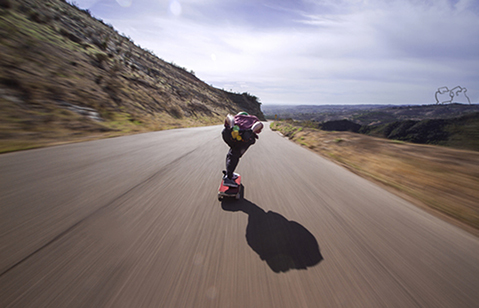‘Wheels Over Paradise’
Director Paul Mathieu

The notion that skateboarding runs on a 40-year cycle helps explain the burgeoning popularity of downhilling, that simplest and most dangerous genre that peaked in the mid-1970s. Back then, four-wheeled adrenaline jockeys — tucked like Olympic ski jumpers on approach — reached freeway speeds with little more than a foot drag or hay bale to help them slow down. These days, practiced downhillers maintain control with speed-scrubbing slides, a widely refined technique beautifully captured in this one-hour documentary set in the mountains above Santa Barbara.
Teaming up with downhiller and cameraman Tom Flinchbaugh, director Paul Mathieu deploys aerial and follow-cam footage to capture small crews of free-riding friends chasing bliss down the region’s steepest ribbons of asphalt. Though spaced with sit-down interviews covering history, run-ins with law enforcement, and one rider’s near-fatal crash, the film finds itself at its best when it simply presses the record button, cranks up the tunes, and jumps on for the ride.
WORLD PREMIERE
It’s more than just the great views that make Santa Barbara a great downhilling hotspot, right?
The hills right above us are another world. Santa Barbara has always been a downhill paradise. We’ve got Kevin Reimer, the 2014 IDF World Champion. The best skateboard wheels in the world are made right here in Goleta, at Powell Peralta. Arbor Collective is downtown with amazing board designs. And it still has that counter-culture feel. Downhillers are the outlaws, the guys and girls on the fringe.
You were faced with a bit of a time crunch on this. Explain.
I read an article in The Santa Barbara Independent this past summer about the proposed county ban on downhill skateboarding [on certain roads]. I’m not a skateboarder, but something about the camaraderie of the sport intrigued me. I sought out Tom Flinchbaugh and essentially declared we’re going to make a movie together. Tom is an experienced skater and downhill cinematographer, so he must have thought I was just crazy enough to be serious. We knew the ban would most likely pass, so it became a race to film the riders, develop the storylines, and have the film edited in time for SBIFF. Our story is timely, so I wanted to premiere this festival season and not wait another year.
What would you have done with more time?
My favorite films, both fiction and nonfiction, capture a slice of time that can never be recreated. With the narrative films I’ve done, I could change a thousand things. I’ve learned to let documentaries just live in their own time and place. Interviews are always more organic during the first round of conversation. It would have been nice to have more time with the riders, however, because it was exciting.
What were the difficulties in making the film?
Logistics. This is a tough sport to document. Weather, light, and the downhill runs are all really, really variable. To have everything come together and maintain an authentic experience is tricky.



